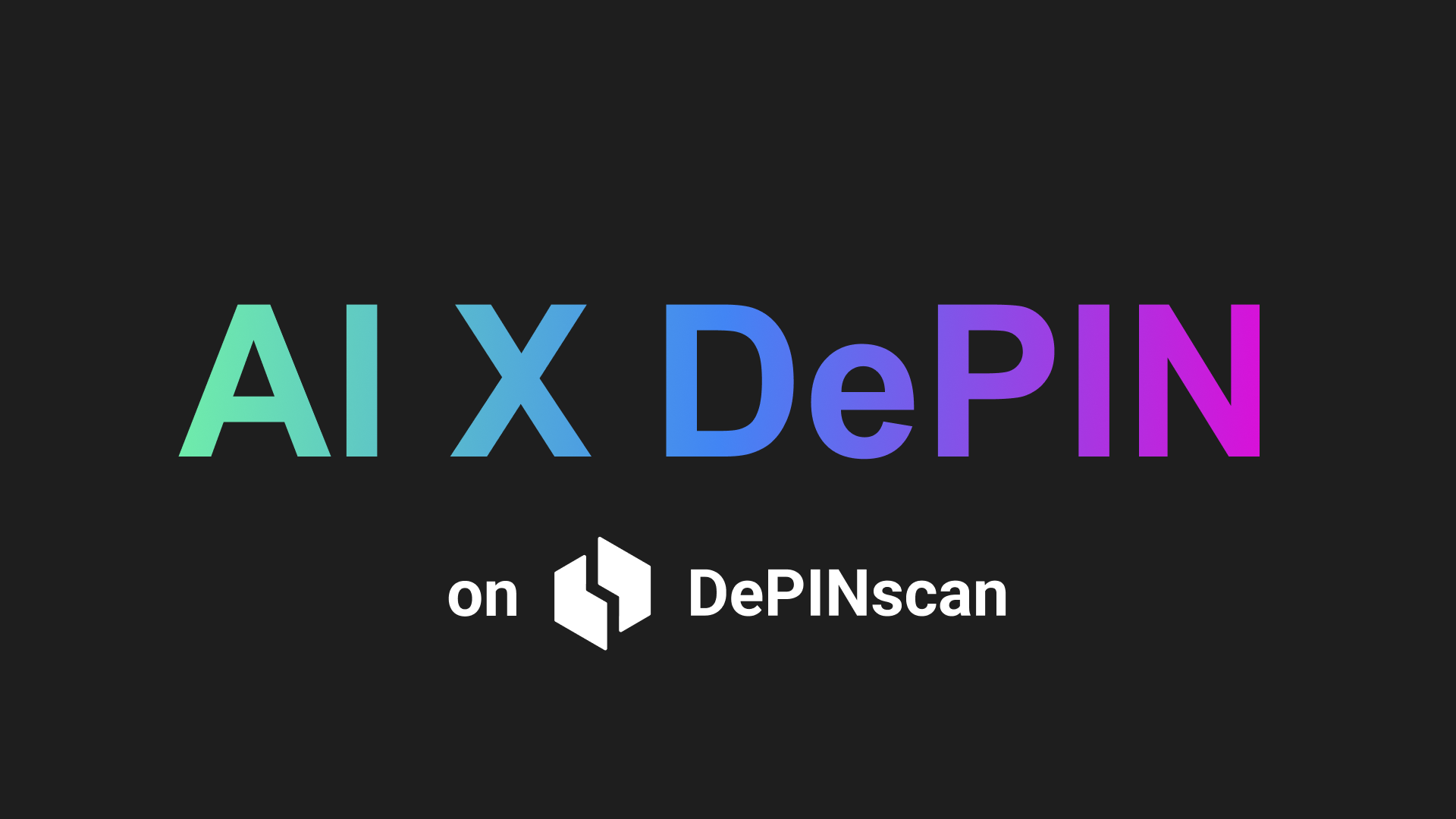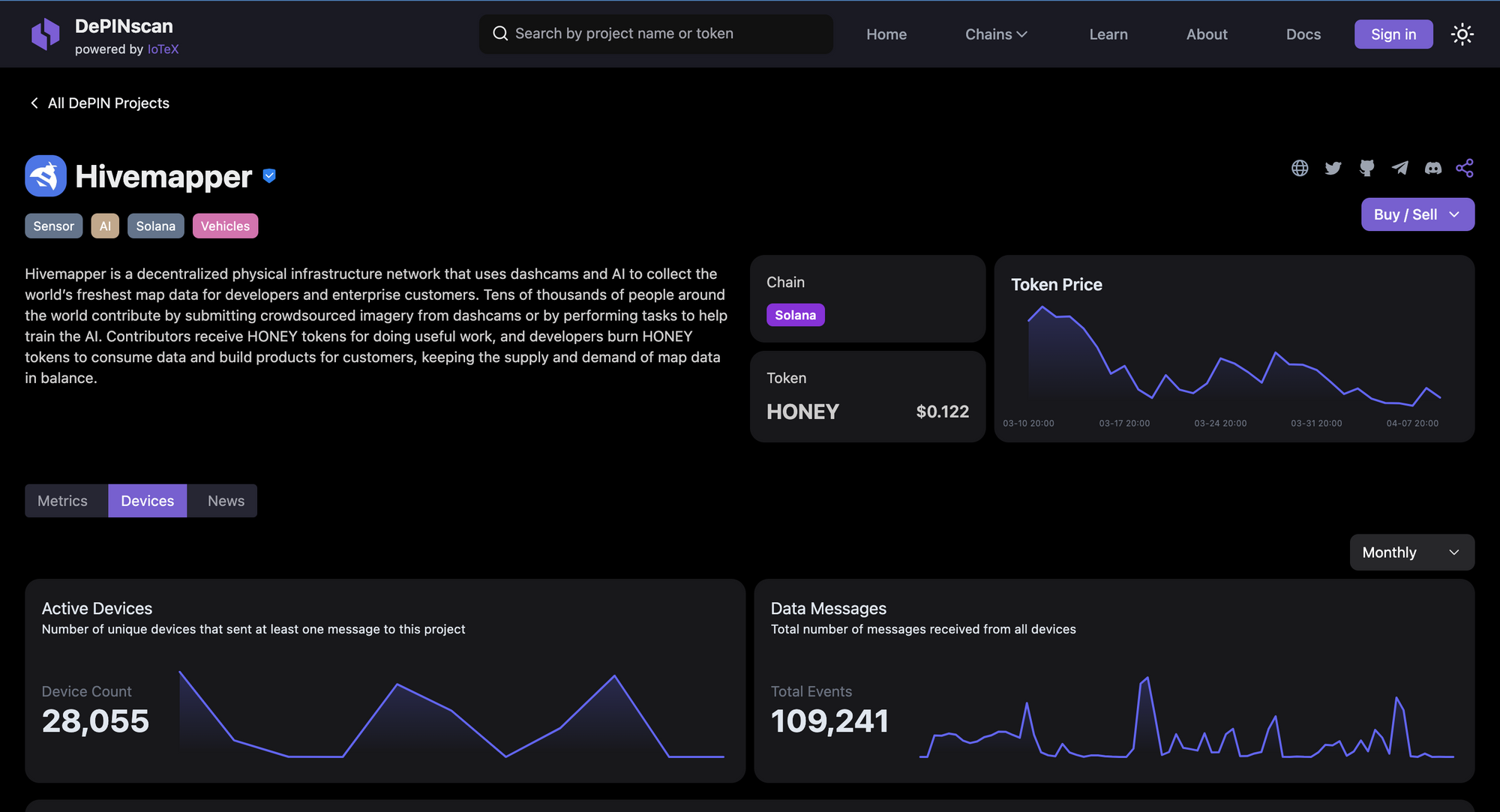Now Tracking On DePINscan: AI X DePIN
We're thrilled to announce the launch of the new AI tab on DePINscan. This exciting addition provides a constantly updated directory of projects pioneering the intersection of AI and DePIN.

On the cusp of a golden age stand two of the most transformative technologies of our time: Artificial Intelligence (AI) and blockchain. Within the realm of blockchain, Decentralized Physical Infrastructure Networks (DePINs) are poised to revolutionize ownership of massive infrastructure projects.
Recognizing this potential, IoTeX built DePINscan – a public good that fosters transparency, project discovery, and data aggregation for the DePIN community. Today, we're thrilled to announce the launch of the new AI tab on DePINscan. This exciting addition provides a constantly updated directory of projects pioneering the intersection of AI and DePIN.
AI's Hunger for Resources: A DePIN Solution
DePINs disrupt traditional models by leveraging crypto-economic incentives to fuel crowdsourced development. This fundamentally alters how we conceptualize and construct the world around us. Messari, a digital asset intelligence firm, estimates the DePIN market's current valuation at nearly $2.2 trillion, with a projected growth trajectory to $3.5 trillion within the next four years.
Read more: What are Decentralized Physical Infrastructure Networks (DePIN)?
The ongoing explosion in artificial intelligence, particularly the development of Large Language Models (LLMs), is not just a technological marvel, but a potential economic game-changer. Across all industries, it is estimated that generative AI could generate a potential value of $2.6 trillion to $4.4 trillion.
AI model training is an eleven-figure industry in its own right, and demand for compute is outstripping supply. The primary GPU manufacturer, Nvidia, is a $2+ trillion business.
Here's where DePIN and AI forge a symbiotic relationship. DePIN bridges the compute gap through decentralized GPU networks like Akash, InferixGPU, EMC, and many more. These platforms allow individuals to contribute their unused consumer-grade GPUs, creating a crowdsourced pool of processing power that rivals centralized giants. DePIN democratizes access to AI compute, making it more affordable and user-friendly.
Network3 exemplifies this innovative approach. Their "EdgeFi" concept leverages the power of everyday devices like home computers, smartphones, and IoT gadgets for decentralized AI training. Anyone can contribute their devices and receive crypto incentives – a form of passive income. Their "federated learning" technique safeguards user privacy by splitting models across numerous independent training devices, while simultaneously harnessing the collective power of the crowd.
Imagine the countless Nvidia GPUs rendered idle by Ethereum's shift to proof-of-stake. These very devices could be contributing to Render Protocol's decentralized compute power.
DePIN's impact extends beyond compute to the crucial realm of data. According to Allied Market Research, the AI training dataset market is poised for significant growth, reaching an estimated $9.3 billion by 2031 (from $1.4 billion in 2021). Researchers have even warned that AI may run out of data by 2026.
Grass CEO Andrej succinctly captures this data dependency: "Any AI model requires two inputs: parameters (compute) and tokens (data). Scaling one necessitates scaling the other. Adding parameters for a more powerful AI without high-quality data is a waste of resources."
Projects like Grass address this data challenge by leveraging DePIN. Millions of users contribute their unused bandwidth in exchange for rewards. This vast amount of web data fuels the training of Large Language Models (LLMs) in a verifiable and tamper-proof manner.
IoTeX Enabling AI X DePIN
IoTeX serves as the backbone for DePIN. It provides modular building blocks for constructing DePINs and fosters the development of DePIN as a whole through public goods initiatives. IoTeX empowers the creation of thousands of new physical infrastructure networks, transforming idle devices into collaborative economic engines. Most importantly, it aggregates real-time, real-world data across these DePIN networks.
The vision for IoTeX is to become the premier decentralized hub for data and devices. This will pave the way for training advanced LLMs and constructing cutting-edge AI agents, ultimately unlocking immense value in the new digital landscape. Several DePIN x AI projects, including InferixGPU and Network3, have recently announced the launch of their native tokens on IoTeX.
DePINscan, a crucial resource from IoTeX, offers a trusted and verifiable platform for DePIN data, project discovery, and transparent communication between DePIN projects and the community. Think of it as a superior CoinMarketCap specifically designed for DePIN. As the DePIN and AI sector flourishes, DePINscan introduces its new AI tab. This continuously updated roster showcases DePIN and AI projects pioneering this exciting technological convergence.

Projects at the forefront
There are countless use-cases, angles, and approaches to building at the intersection of AI and DePIN. Let’s take a look at some of the AI X DePIN projects at the forefront that are integrated with DePINscan.
Aethir
Aethir provides a cutting-edge solution to the global compute resource shortage through its enterprise-grade GPU-as-a-service platform. By aggregating idle and new GPUs, Aethir supports essential industries like AI and gaming with decentralized cloud computing. This infrastructure allows GPU providers to fuel advanced applications worldwide, with Aethir playing a pivotal role in cloud gaming, bolstered by partnerships with leading gaming and telecom companies to form a dynamic ecosystem.
Io.net
io.net formerly delivers a set of products, clients and libraries that allow machine learning teams to access distributed Cloud clusters permissionless and at a small fraction of the cost of comparable centralized services by aggregating the worlds scattered GPU supply. This creates a cost-effective marketplace for AI/Machine Learning (ML) teams. Ionet allows users to leverage this distributed network for tasks like parallel training, hyperparameter tuning, and inference.
Render Network
Render introduces a decentralized platform designed to meet the demands of modern media production, offering unparalleled rendering capabilities. This platform leverages distributed computing to enhance the efficiency and cost-effectiveness of rendering processes, catering to the next generation of media creation. Render represents a significant leap forward, democratizing access to high-end rendering tools for creators worldwide.
Nosana
Nosana is redefining the GPU grid landscape by offering an unmatched cost-effective solution tailored for AI inference workloads. By integrating with the Solana blockchain and utilizing the $NOS token, Nosana enables consumers, miners, and businesses to monetize idle hardware, fostering a more efficient and decentralized computing ecosystem. This platform not only maximizes resource utilization but also promotes a collaborative economy in the tech space.
Grass
Grass is an innovative layer 2 solution dedicated to sourcing and structuring training data for the AI industry. By employing a global network of web scraping nodes, it not only collects data from the public web but also verifies its origin on-chain, establishing a sovereign data rollup. This unique infrastructure allows participants from over 190 countries to contribute to and benefit from the AI revolution, creating a more equitable distribution of value within the AI ecosystem.
Hivemapper
Hivemapper is an innovative decentralized network that revolutionizes map data collection through dashcams and artificial intelligence, providing developers and enterprises with the most current map information. It harnesses the power of crowdsourcing, with tens of thousands of contributors worldwide, to gather fresh imagery and refine AI algorithms. This community-driven approach ensures that Hivemapper's maps are always up to date, offering a dynamic and comprehensive view of the world that traditional mapping services can't match.
Theta
Theta stands at the forefront of decentralized technology, offering a blockchain-based cloud solution specifically designed for AI, media, and entertainment. By allowing users to share their excess computing resources, Theta transforms the landscape of video streaming and AI computations, making them more efficient and less dependent on centralized content delivery networks. This pioneering platform not only democratizes digital content distribution but also paves the way for a more connected and accessible online world.
Akash
Akash Network introduces an open-source supercloud, a marketplace where users can securely and efficiently trade computing resources, such as GPU power. This platform empowers individuals to contribute their unused computing capabilities to a vast network, competing with and potentially surpassing centralized cloud providers. Akash democratizes AI and machine learning, making these technologies more affordable and accessible to a broader audience by leveraging decentralized networks.
CUDOS
CUDOS is reshaping the cloud computing landscape with its Intercloud platform, enabling the seamless, secure, and anonymous rental of scalable computing resources. Users can easily activate virtual machines across a global network by simply connecting their digital wallets, promoting the democratization of cloud services. This innovative approach offers an egalitarian access to computing power, requiring no personal information, only a crypto wallet, thus maintaining user privacy and security.
Network3
Network3 is an advanced technology initiative dedicated to creating a specialized AI Layer2 for developers around the globe. It streamlines the training and deployment of AI models by offering optimization, compression, federated learning, and confidential computing services. This project embodies the future of AI, striving for a world where technology serves humanity through collective intelligence, marking a significant step towards a smarter, more united future.
Inferix
Inferix emerges as a groundbreaking decentralized computing platform, focusing on visual computing realms such as 3D modeling, virtual reality, and artificial intelligence. Spearheaded by House3D's Freddie Nguyen, it commands a significant presence in Vietnam and is rapidly expanding its horizons globally. Inferix is not just expanding geographically but also technologically, by developing an AI inference engine that utilizes its robust GPU network, aiming to amplify human intellect across various domains.
Phala Network
Phala Network is a DePIN powered Coprocessor for AI. Building at the forefront of innovation with its AI Agent Contract platform, Phala is transforming decentralized AI agents. Builders can revolutionize AI agents with tokenomics and governance control, ensuring operation within a decentralized framework that eliminates central authority control. Phala creates a system that allows AI Agents to run in a highly secure TEE network, while fully controlled by on-chain smart contracts. This is what Phala is good at.
The intersection of AI and DePIN is not just a novel concept but a foundational shift in how we approach technology and its applications in our daily lives. As IoTeX's DePINscan introduces its AI tab, it marks a significant milestone in this journey, showcasing projects that are at the forefront of this technological convergence. These initiatives, ranging from Hivemapper's dynamic mapping solutions to Nosana's decentralized GPU grid, illustrate the vast potential of combining AI with DePIN to solve real-world challenges. They represent a new era where technology is more accessible, equitable, and aligned with the needs of a rapidly evolving world. As we stand on the brink of this golden age, it's clear that the fusion of AI and DePIN will not only drive innovation but also foster a more connected, intelligent, and humane future for all.
